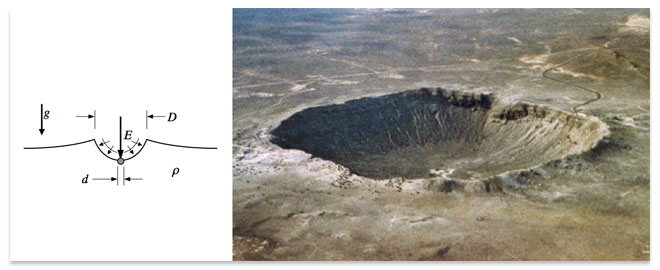
ME Professor David Dowling partnered with his son, Thomas, to create an experiment that involves the formation of small impact craters in granular materials and then identifying parametric trends with dimensional analysis. Together, they have written an article outlining the experiment and its implications, which has been selected by the American Association of Physics Teachers’ Journal to be published in November 2013.
Dowling was initially introduced to the idea of studying crater formation while watching Bill Nye the Science Guy, who used a slingshot to launch a projectile into a bed of flour. Years later, Dowling’s third son, Thomas, decided to quantitatively recreate the experiment for a science fair project during his sophomore year of high school. The results were more significant than expected, as Dowling realized that the simple high school project could serve as a shockingly accurate predictor of the impact energy that created the Barringer Meteor Crater in Northern Arizona.
Dowling and his son gathered some household items including a mixing bowl, bag of sand, two bags of granulated sugar, and various spherical objects such as super balls and golf balls. In the garage, they dropped seven spheres of various sizes into a bed of sand, and then sugar, from four different heights, and recorded the diameter of each small impact crater. The crater-diameter results were then found to depend only on 3 parameters (kinetic energy lost on impact, acceleration of gravity, and density of the granular material) through a simple algebraic relationship.
Dowling said that after extrapolating his son’s results to the size of the Barringer Meteor Crater, he found that prior geophysical estimates of the crater’s formation energy fit the same scaling relationship as the simple experimental results. Thus, by inverting the measured algebraic relationship, the results from simple, inexpensive, and safe experiments could be used to make an independent prediction the Barringer crater’s impressive impact energy, 500 to 1000 times greater than that released by either of the atomic weapons that ended WW II in the Pacific.
“You don’t need a lot of fancy physics to explain the Barringer Meteor Crater,” Dowling said. “All you need to know are a few physical parameters from the impact site; the physics appears to be the same for laboratory and geo-physical crater formation.”
The article, soon to be published, includes both the log-log graph and parameter table, and explains the accessibility of the experiment, suggesting its value in both high school and undergraduate instruction.
“At the undergrad level, you can have them formulate the theory from dimensional analysis, and at the high school level, you can hand them the theory and say, ‘see if it works.’” Dowling added. “It’s a good, inexpensive way to teach the scientific method, and the results are immediate.”
Last year, Dowling based an exam question on the experiment, and now uses it as an example for teaching dimensional analysis in his graduate-level course, ME 520 Advanced Fluid Mechanics. In addition, he is currently revising his textbook to include the experimental process and the development of the crater scaling law.
Fluid mechanics, which includes the study of flowing unconsolidated granular material such as the fractured sandstone that holds the shape of the impact crater in Arizona, has always intrigued Dowling. Before deciding to study fluid mechanics academically, Dowling enjoyed water sports as a child; hence, he had already gained some knowledge of the topic before learning how to tackle the complicated mathematical problems that would inevitably come along later in his education.
Additionally, he said that many concepts related to physics, such as the study of electromagnetic waves, are less accessible than fluid mechanics because they are invisible to the naked eye and intangible.
“Fluid mechanics is the nonlinear field theory you can see,” Dowling said. “I can observe it myself, I don’t need a lot of special equipment; I can go outside and look.”
Dowling’s impact crater experiment is accessible not only because its results are immediate and visible, but also because it was done at home, in a garage. Anyone can replicate the results for themselves.
“Every time I describe this to someone, it almost always brings a smile to their face as they say, ‘you did that in your garage and now you can predict the energy associated with this giant crater,’” Dowling said. “People just like that.”
Read the article: http://link.aip.org/link/?AJP/81/875&aemail=author
